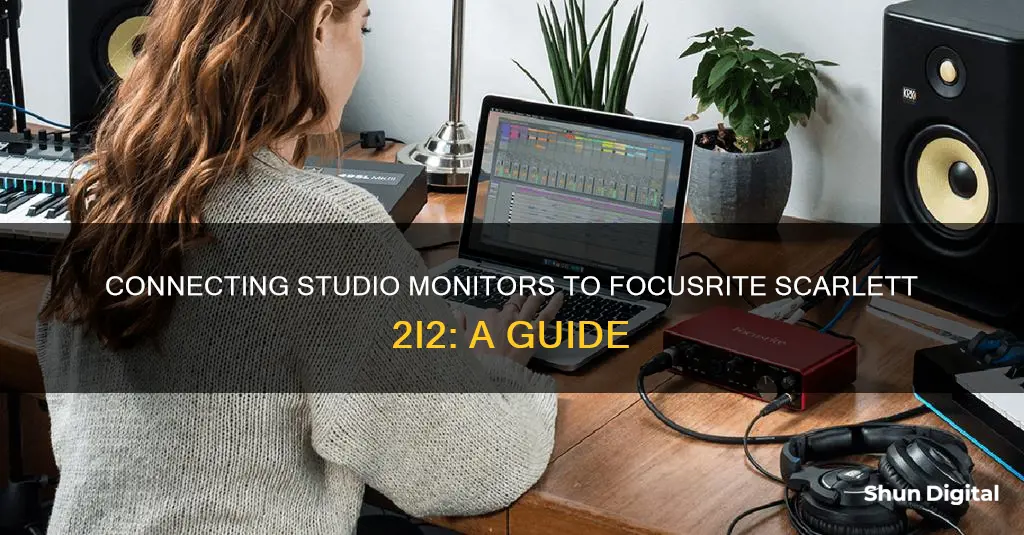
If you want to connect your studio monitors to your Focusrite Scarlett 2i2, you'll need to use cables. The type of cable you use will depend on the inputs on the back of your studio monitors. Most modern studio monitors have 1/4 or XLR inputs, but some may have RCA inputs.
You can use either a balanced 1/4 TRS cable or a balanced 1/4 TRS to XLR cable to connect your Focusrite Scarlett 2i2 to studio monitors with 1/4 or XLR inputs, respectively. These cables provide better sound quality and are less prone to interference and noise than unbalanced cables.
If your studio monitors only have RCA inputs, you'll need to use an unbalanced 1/4 TS to RCA cable. This type of cable is less ideal, as it is more susceptible to interference and noise.
Make sure to connect the left and right outputs on your Focusrite Scarlett 2i2 to the corresponding inputs on your studio monitors.
| Characteristics | Values |
|---|---|
| Recommended cables | Balanced 1/4" TRS cables, XLR cables, TRS to XLR cables, unbalanced 1/4" TS cables, TS to RCA cables |
| Cable features | Two rings indicate a balanced connection, one ring indicates an unbalanced connection |
| Cable recommendations | Amazon Basics XLR Cables, Hosa Technology XLR Cables, Mogami Gold Studio XLR Cables, Behringer Xenyx Q1202 USB, Rode Rodecaster Pro 2, TC Helicon GoXLR Mini, Behringer U-Phoria UMC22 |
| Other recommendations | Power amp, power conditioner or power strip |
What You'll Learn

Balanced 1/4 TRS cables are best
When connecting studio monitors to the Focusrite Scarlett 2i2, it is recommended to use balanced 1/4" TRS cables. This type of cable provides several advantages that make it the best choice for this particular setup.
Firstly, balanced 1/4" TRS cables offer superior sound quality compared to unbalanced cables. They send two versions of the audio signal – one normal and one phase-inverted – which allows for effective noise cancellation at the receiving end. This results in a clearer and more accurate audio output.
Secondly, the balanced connection provided by TRS cables enables longer cable runs. This is especially useful if your studio setup requires cables that span greater distances between the Scarlett 2i2 and the studio monitors. With TRS cables, you can achieve longer cable lengths without sacrificing sound quality or introducing interference.
Additionally, balanced 1/4" TRS cables are widely available and easy to source. They are a standard option for connecting audio equipment, and you can find them at most electronics retailers or online stores. This convenience makes it simple to acquire the necessary cables for your studio setup.
Moreover, balanced 1/4" TRS cables are highly durable and reliable. They are designed with robust connectors, such as nickel-plated plugs, which ensure efficient signal transfer and enhance the overall signal clarity. The cables themselves are typically made with oxygen-free copper (OFC) conductors, which provide enhanced signal clarity and effective rejection of electromagnetic interference (EMI) and radio-frequency interference (RFI). This construction ensures a consistent and high-quality audio signal.
Lastly, balanced 1/4" TRS cables are versatile and can be used with a variety of audio equipment. They are commonly used with studio monitors, audio interfaces, and other pro audio gear that features balanced phone jacks. This versatility allows you to use the same type of cable for multiple components in your studio setup, simplifying your cabling needs.
In conclusion, balanced 1/4" TRS cables are the best choice for connecting studio monitors to the Focusrite Scarlett 2i2. They offer superior sound quality, support longer cable runs, are easy to source, provide durability and reliability, and can be used with a wide range of audio equipment. By opting for balanced TRS cables, you can ensure optimal performance and a high-quality audio experience in your studio setup.
Discovering Monitor MFC: A Simple Guide to Checking
You may want to see also

Use a balanced 1/4 TRS to XLR cable
Using a balanced 1/4 TRS to XLR cable is a great way to connect your Focusrite Scarlett 2i2 to studio monitors. This type of cable provides a balanced connection, which offers better sound quality and reduces interference from other electronic devices or cables. It is a simple and effective method that only requires you to connect the left and right outputs of the Scarlett 2i2 to the corresponding inputs on your studio monitors.
When choosing a cable, make sure to get one of good quality. While you don't need to spend a fortune, avoid the cheapest options as they may not provide the same level of noise reduction. Additionally, make sure the cable has the correct connectors for your equipment. In this case, you'll need a cable with a 1/4" TRS connector on one end and an XLR connector on the other.
Before connecting the cable, take a look at the back of your studio monitors. They should have a pair of inputs marked as "Balanced" or "BAL". If your monitors have XLR female inputs, you'll need a TRS male-to-XLR male cable. The female connector is the one with holes, while the male connector has pins.
Once you have the correct cable and have identified the inputs on your monitors, simply connect the Scarlett 2i2 outputs to the studio monitor inputs using the cable. Make sure to connect the left and right outputs to the corresponding inputs on the monitors.
Using this method, you can benefit from the convenience and sound quality of a balanced connection. It's a straightforward way to connect your Focusrite Scarlett 2i2 to studio monitors with XLR inputs.
Breaking in Your New Studio Monitors: A Quick Guide
You may want to see also

Unbalanced 1/4 TS cables will work
Unbalanced 1/4" TS cables will work to connect your Focusrite Scarlett 2i2 to studio monitors, but they are more susceptible to noise and interference from other electrical equipment. TS cables have one ring, which means they send one version of the audio signal. This makes them more prone to audio, magnetic, and electrical interference.
If you opt for unbalanced TS cables, you should keep the cables as short as possible to reduce the likelihood of interference. Longer cables provide more opportunity for unwanted noise to enter the signal.
While TS cables will work, it is recommended to use balanced cables wherever possible to achieve the best sound quality. Balanced cables have two rings and send two versions of the audio signal (one normal and one phase-inverted). This allows the signals to be compared at the receiving end to prevent noise.
If you decide to use unbalanced 1/4" TS cables, the setup is simple. Connect the Scarlett 2i2 1/4" outputs to the unbalanced 1/4" TS cables, and then connect the other end of the TS cables to the speaker 1/4" inputs. Just be sure to connect the left and right outputs to the corresponding speaker.
Best Places to Buy Refurbished Monitors
You may want to see also

Unbalanced 1/4 TS to RCA cable as a last resort
Unbalanced 1/4" TS to RCA Cable as a Last Resort
If your studio monitors only have RCA inputs, you will need to use an unbalanced cable with a TS (Tip Sleeve) phone plug at one end and an RCA (Radio Corporation of America) phono plug at the other. This type of cable is ideal for sending signals from gear with unbalanced phone jacks to gear with phono jacks, such as an RCA-compatible speaker system.
Both TS cables and RCA cables use an unbalanced signal, which means that one of the wires is used for the signal and as the ground wire. This makes the cable cheaper and easier to assemble, but it also means that it is more susceptible to noise and interference. To reduce the risk of unwanted noise, keep your unbalanced TS to RCA cable runs under 25 feet.
You can find a range of suitable cables from brands like Hosa, Mogami, Pro Co, and Roland. When purchasing a cable, make sure that it is long enough to reach both speakers when you zip it apart.
Finding a Co-founder: Monitor Your Success with These Tips
You may want to see also

Avoid expensive cables
When it comes to connecting studio monitors to the Focusrite Scarlett 2i2, you might be tempted to invest in expensive cables to ensure the best sound quality and avoid any issues. However, this may not be necessary, and there are ways to avoid spending a fortune on cables without compromising on performance. Here are some insights and recommendations to help you make an informed decision:
Firstly, understand the difference between balanced and unbalanced cables. Balanced cables, such as those with TRS (Tip-Ring-Sleeve) connectors, offer better sound quality and are less prone to interference and noise. Unbalanced cables, like those with TS (Tip-Sleeve) connectors, are more susceptible to audio, magnetic, and electrical interference. While balanced cables are generally recommended, they also tend to be more expensive.
For the Focusrite Scarlett 2i2, using balanced 1/4" TRS cables is the simplest and most effective method. These cables provide the best sound quality and facilitate longer cable runs if needed. They are also easy to find and source, making them a convenient option. However, there is no need to overspend on premium brands, as basic options will work just fine.
If your studio monitors have XLR inputs, you can use balanced 1/4" TRS to XLR cables. XLR connectors can be more convenient to work with and are widely available. Again, there is no need to spend a fortune on expensive XLR cables, as even basic options will provide a good connection.
Unbalanced 1/4" TS cables can also be used with the Focusrite Scarlett 2i2, but they are more likely to introduce buzzing or humming noises due to interference. If you opt for this type of cable, be sure to get a good-quality one to minimise the chances of interference.
In summary, while it's important to use the right type of cable for your setup, you don't necessarily need to spend a lot of money on expensive cables. Basic options that meet the required specifications will generally work just fine. Focus on getting the correct connectors and cable length for your needs, and don't be drawn in by marketing hype or unnecessary add-ons like gold plating.
Adjusting Screen Display: Restoring Font Size on Your Monitor
You may want to see also
Frequently asked questions
You will need two male-to-male TRS cables or male-to-male TRS-XLR cables.
Connect one monitor with a TRS cable to the left output of the Scarlett 2i2 and the other monitor with another TRS cable to the right output.
Yes, there are separate power cables for each monitor.
You and the monitors should form an equal-sided triangle with the monitors aimed straight at you.
Balanced audio cables have two rings, while unbalanced audio cables have one ring.







